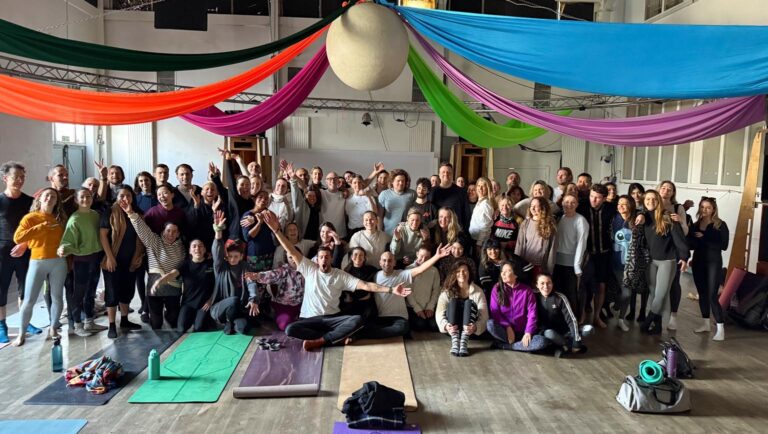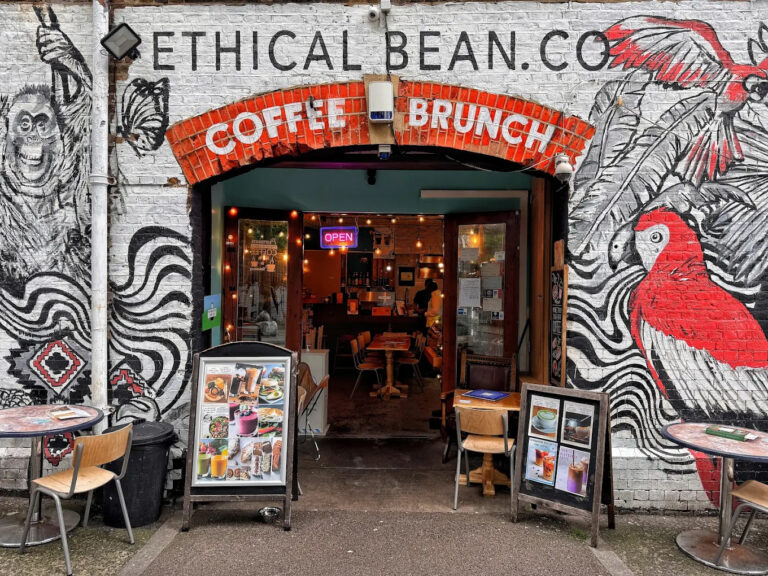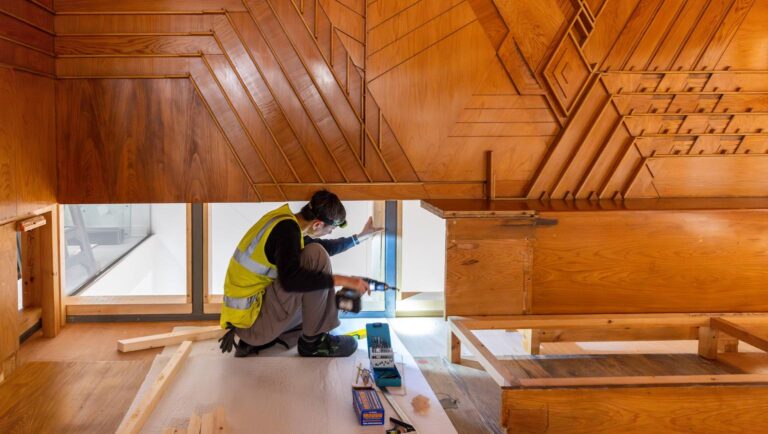
Mattia from Community Yoga Project on the joy of human connection
Exploring the health advantages of belonging to something bigger than ourselves
Artist Aida Wilde is angry. She asked for local legend Edwin’s iconic slogan, ‘SHITHOUSE TO PENTHOUSE’ – an artwork curated by her – to be removed from the newly refurbished Lord Napier pub. She didn’t want the incoming landlords to financially benefit from Edwin’s cheeky provocation. Aida rightly asks, “I caused Hackney Wick to become gentrified. Now, where is my 10%?”
The word gentrification is now a wince-inducing cliché. Decaying edges of the city are occupied by skint artists. Things get edgy. Parties happen. Culture explodes. Developers move in and sell the dream. Quickly, commercial interests sour the mood; what was grimy now becomes polished, and poor people are displaced, including the artists who made the area hip in the first place. Can this process be reversed? Is there such a thing as positive gentrification? How do poor people get a seat at the table, when planning decisions are made about them? London has been asking itself this question repeatedly over the last thirty years. Our Prime Minister and Mayor wax lyrical about the need to protect our creative capital. And here we all are, in Hackney Wick, hidden behind black gates and red gates; hundreds of artists, hungry for work and life. How do we provide pathways for artists and developers to meet, and possibly even collaborate? Where literally everybody wins, artists get paid, and the world is made better through arts and culture?

The likelihood of getting on the housing ladder is a distant dream for most British artists, and unlike in Germany, we don’t have rent control. One way for a gentrified area to keep its artists is to provide affordable studio space, so the skint ones don’t have to move back to their mum’s house. Juliet Can is the director of local workspace provider Stour Trust. She was thrilled when a company called Future Generation approached her with the offer of 125 years free rent; it meant she could really operate as an affordable space. But after the planning application was passed, Juliet noticed that the terms of the offer had been changed; rent would not be free, and neither would Stour Trust necessarily get the contract to be the workspace provider.
This is a simple hack for some developers; one of the ways to circumnavigate the requirements of planning is to renege on promises made to secure the support of the community. (After being approached to comment for this article, CEO of Future Generation, Tom Slingsby, said: “We’ve had several meetings with Stour Trust and LLDC* this week and we’re working hard to find a solution that’s acceptable to everyone concerned.”) Juliet Can had previously been frustrated after her attempts to become the workspace provider for the new build Carpenters Wharf were unsuccessful. That developer, Anderson Group, had apparently asked for tenders from local workspace providers, but decided to run a commercial gallery themselves.
Michaela YearwoodDan is the first consulting director for Anderson Contemporary Gallery. Initially offered a residency as a painter, with two years of free studio space, Yearwood-Dan says, “Anderson Group were meant to open a gallery, but it felt like the idea was dropping off their radar. They weren’t an arts organisation, so didn’t know the ins and outs.” So Michaela helped Anderson Group set up the gallery, and a job as gallery director will become available once she moves on. “I know the system because I’ve been part of it,” she tells me. “I’ve been kicked out of spaces too. I know how it benefits some and not others. I want to make the arts accessible to all.”

Yearwood-Dan is fond of Anderson Group’s CEO, Andrew Jay. “Andrew has this really lovely way about him,” she says. “His attitude is ‘I am clueless here, Michaela. Tell me what needs to be done.’” She waxes lyrical about the positive legacy of Anderson Contemporary Gallery. “There is a connection between artists and the builders who constructed the site, who – let’s face it – are craftsmen. Site managers come to openings; builders know residents by names, and now have artist mates. Everybody wants it to succeed.”
“What is acceptable support for the creative sector that has integrity and which developers do we remain cynical about? What is art-washing, and what is genuine?” asks William Chamberlain, of Creative Wick [co-founder of this newspaper], who sees a clear relationship between the business and creative sectors; “If the development sector uses the creative sector in its advertising to sell homes, then surely they must invest some of their profits back into the community they borrowed from.” William suggests the situation is complex. “If it’s genuine in intent, does it actually deliver value? And why is it that the good guys are persecuted, whilst the worst culprits go unnoticed?”
There are examples of great projects in Hackney Wick, which are creating tangible legacy. Aitch Group, developers of the Bagel Factory, proudly proclaim their corporate social responsibility; one of their successes is the Wickers, a well-known knife crime charity. Telford Homes commissioned artist Alex Fox to build gates on their new Wallace Road development, and sold their studios to Community Land Trust, who in turn appointed studio provider Cell to manage these studios at affordable rates; yet even good guys can get it wrong. Telford Homes also had to work hard to appease residents affected by industrial waste, inadvertently uncovered on their building site.


Watching their poor workers struggle with graffiti, essentially creating blank canvases week upon week by painting out the previous week’s indiscretions, was painfully comical in its pointlessness and waste of resources. As buildings rise and fall within this rapidly changing palimpsest, so do artworks, partnerships, and promises. Some ideas last longer than others. Some decay, and wither away, a fleeting memory, a moment in time, a moment of resistance to change. (Change! A force both creative and destructive by nature!) Hill built Fish Island Village with Peabody, one of the oldest housing associations in the country, celebrated for being publicfacing and community-minded, who will manage the estate. All sorts of investments have already been made by Hill and Peabody; quiet public art commissions by local artists.
Alongside the canal, opposite a “famous graffiti wall” and in sight of Edwin’s ‘Broken Homes’, an ornate iron drain cover by artist William Cobbing quietly and unassumingly lies in the ground. It houses an inspirational quote by Michaela Coel, about her hustle to sell tickets for the first ever Chewing Gum performance at local theatre, the Yard. The graffiti will come and go – even the famous graffiti wall’s days may be numbered, but for hundreds of years, children born on that estate will be inspired by that quotation. This is true legacy.
Peabody are obviously a company who put their money where their mouth is; so what about the ground floor spaces across their ten buildings? Surely they are affordable? Peabody created a landmark deal with the Trampery, a not-for-profit social enterprise who would occupy and manage ground-floor spaces for twenty five years. Whilst the Trampery’s vision to support the acceleration of sustainable British fashion is impressive, socially conscious and sustainable, space is offered at £30 per sq ft, with only one out of the ten buildings being offered to local businesses.

I asked the Trampery’s Patrick Scally if he considered this an affordable rate. “All our profit from rent goes back into administration, and programmes,” he replied. “We’ve had to close past schemes because we couldn’t pass down rent increases to our members. We have a similar project a couple of miles away in Aberfeldy Village, partnering with Poplar Harca and UAL (University of the Arts London), where tenants pay £16 per sq ft. We try to only work with local providers. The larger we get, the harder it is, but we try to hold ourselves to account.” The ‘Broken Homes’ building is on a piece of land earmarked for one of the most ambitious developments in Hackney Wick.
The website of Ash Sakula, architect for the huge Wickside development (built by Galliard Homes), reads, “Although these buildings were not important heritage assets, being neither nationally nor locally listed, their retention provides continuity and an abode for shared memories of the former uses of the site. One shed is turned into a restaurant, another becomes a gallery. Other existing buildings house mixed uses including apartments, creative workplaces, a public roof terrace and an artists’ foundry. A famous graffiti wall is preserved and becomes part of a café.” Will Edwin finally get his 10%? Galliard Homes probably made sure the wording is perfect; “Although these buildings were not important heritage assets, being neither nationally nor locally listed” kind of gives them the option to knock them down if they don’t fit into money-making plans; alternately, if they are a benevolent and intelligent developer, they could talk to one of the many internationally renowned artists who will be financially forced to relocate, and offer them a permanent home in the community, becoming celebrated for doing so, and thus selling more homes in the process. It’s a no-brainer.
Alex Russell is executive chair of the Community Development Trust, an initiative set up by local social enterprises concerned about the impact of property development on the heritage and culture of the area. Their mission is to preserve spaces for community ownership in perpetuity. “There are so many stakeholders, and a complex policy landscape, she tells me. “This means there’s a lot of frustration between different parties, but the only way to move further is through dialogue. It requires more people who are working in this sector – whether they be developers, planners, landlords, or civic organisations – to come together to address issues and challenges. We’ve mapped the area and we know what is still left to pass through planning; this is our opportunity to get things right, and to create a legacy for arts and culture in Hackney Wick & Fish Island.”

Rome wasn’t built in a day, and neither will East London be. In the statement which declared Hackney Wick & Fish Island as one of London’s first Creative Enterprise Zones, Mayor Sadiq Khan said, “London’s cultural and creative sector is a major contributor to the economy, it can help jumpstart the recovery and bring much-needed tourism to our city. However, support must start at grassroots level, with studio spaces”. Perhaps it is still not too late and together we can create a model of best practice, where developers change their habits and serve their communities, and artists – burned so many times by the subtle intricacies in the small print of planning – are actually given the means by which to survive.
Hackney Wick’s creative community tell me they are exhausted of turning up at endless consultations, only to see their ideas borrowed without credit, concession or remuneration. Yet, on the few plots which still have to pass LLDC’s planning legislation, there remains a window of opportunity to create a legacy for Hackney Wick’s abundant supply of artists before development forces them to find new homes. Maybe we can all work together to find ways in which the business and development sectors can support community and creativity in a manner which feels sustainable and ethical, rather than souring the mood. Let’s see what the shithouse looks like in a decade or two; let’s see whether local artists have flourished, in what our current Mayor has labelled a Creative Enterprise Zone. Perhaps artists can remain, justly paid to question change, at the heart of the party they started.

Exploring the health advantages of belonging to something bigger than ourselves

Your timely reminder to go visit these amazing restaurants, bars and cafes this summer while we wait for better bridge access…

The twist and turns of post-Olympics decision-making that brought 250,000 objects to Here East
A joint venture in collaborative local media from:


In partnership with

Regulated by IMRESSS, the Independent Monitor for the Press CIC.
For more info on our complaints policy, or to make a complaint, visit FAQ.
